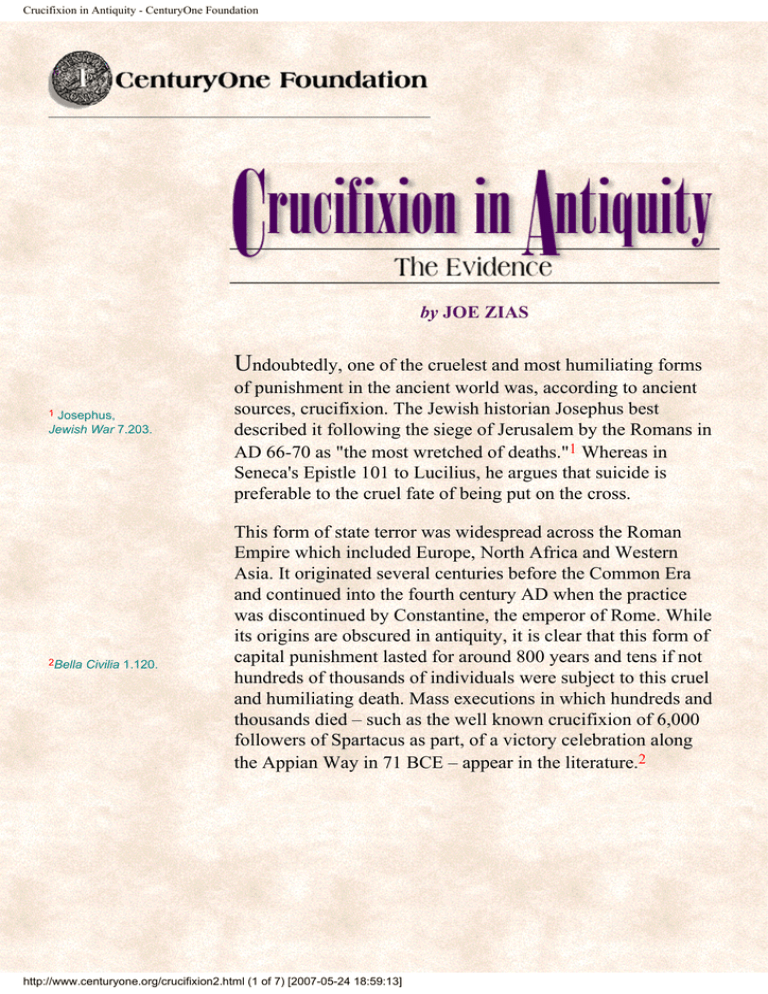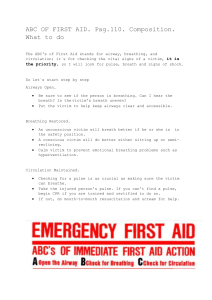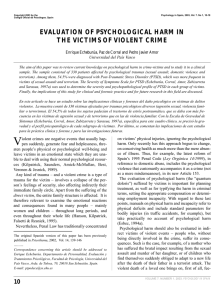Crucifixion in Antiquity
Anuncio

Crucifixion in Antiquity - CenturyOne Foundation by JOE ZIAS Undoubtedly, one of the cruelest and most humiliating forms 1 Josephus, Jewish War 7.203. 2Bella Civilia 1.120. of punishment in the ancient world was, according to ancient sources, crucifixion. The Jewish historian Josephus best described it following the siege of Jerusalem by the Romans in AD 66-70 as "the most wretched of deaths."1 Whereas in Seneca's Epistle 101 to Lucilius, he argues that suicide is preferable to the cruel fate of being put on the cross. This form of state terror was widespread across the Roman Empire which included Europe, North Africa and Western Asia. It originated several centuries before the Common Era and continued into the fourth century AD when the practice was discontinued by Constantine, the emperor of Rome. While its origins are obscured in antiquity, it is clear that this form of capital punishment lasted for around 800 years and tens if not hundreds of thousands of individuals were subject to this cruel and humiliating death. Mass executions in which hundreds and thousands died – such as the well known crucifixion of 6,000 followers of Spartacus as part, of a victory celebration along the Appian Way in 71 BCE – appear in the literature.2 http://www.centuryone.org/crucifixion2.html (1 of 7) [2007-05-24 18:59:13] Crucifixion in Antiquity - CenturyOne Foundation 3 Plutarch (AD 46-120) Mor.554A/B. 4 Curtius Rufus, Hist. Alex. 4.4.17. While many people believe that crucifixion was reserved for criminals only as a result of Plutarch's passage that "each criminal condemned to death bears his cross on his back,"3 the literature clearly shows that this class of individuals were not the only ones subjected to this ultimate fate. Alexander the Great had 2,000 survivors from the siege of Tyre crucified on the shores of the Mediterranean.4 In addition, during the times of Caligula – AD 37-41 – Jews were tortured and crucified in the amphitheater to entertain the inhabitants of Alexandria. Women are seldom if ever mentioned specifically in the ancient sources aside from two passages in the Mishna, one in Tractate Mourning 2.11 which suggests that women may have been sacrificed as well. The second reference is found in Sanhedrin 6.5 in which Simeon B. Shetah had 70 or 80 sorceresses hung in the city of Ashkelon. However, as crucifixion was widely employed with slaves, one can assume that, in the ancient world its use was thus not limited by gender but mainly by class. Crucifixion amongst the Jews was rare and except for a few instances, the subject was stoned to death first and then hung on a tree in accordance with the Biblical passage in Deuteronomy 21:22-23: "When someone is convicted of a crime punishable by death and executed, and you hang him on a tree, his corpse must not remain all night upon the tree; you shall bury him that same day, for anyone hung on a tree is under God's curse." 5 Josephus, Antiquities 12.256. 6 V. There was one notable exception to this passage in which the victims were first killed via crucifixion rather that being hung on a tree after death. This was the case with the high priest, Alexander Janneus in which 800 Pharisees were crucified in Jerusalem in 267 BC before their wives and children. While on the cross, according to Josephus5 the women and children were then slaughtered. Despite this plethora of literary evidence for crucifixion over the centuries in the ancient world, the direct anthropological evidence amounts to but one case from Jerusalem discovered in 1968. THE CRUCIFIED MAN FROM GIV'AT HA-MIVTAR Tzaferis, "Jewish Tombs http://www.centuryone.org/crucifixion2.html (2 of 7) [2007-05-24 18:59:13] Crucifixion in Antiquity - CenturyOne Foundation at and Near Giv'at ha-Mivtar," Israel Exploration Journal 20:31, 1971. In 1968 building contractors working in a suburb north of Jerusalem accidentally uncovered a Jewish tomb dated to the first century after the death of Christ.6 Lying in a Jewish ossuary bearing the Hebrew inscription 'Jehohanan the son of HGQWL' were the skeletal remains of a man in his twenties, who had been crucified. The evidence for this was based on the right calcaneum (heel bone) of the individual, pierced by an iron nail 11.5 cms. in length. The nail penetrated the lateral surface of the bone emerging on the middle of the surface in which the tip of the nail had become bent. The bending of the tip of the nail upon itself suggests that after the nail penetrated the tree or the upright it may have struck a knot in the wood thereby making it difficult to remove from the heel when the victim was taken from the cross. Remains of olive wood found between the head of the nail and the heel bone suggest that prior to penetrating the heel bone the nail was driven through a wooden plaque so as to increase the head of the nail thus making it difficult for the victim to free his legs from the upright. Due to the taphanomic process which occurred over a period of 2,000 years the skeleton was in a poor state of preservation. Being friable and fragmentary, with many postmortem breaks, the right heel bone was not amenable for proper anthropological investigation. http://www.centuryone.org/crucifixion2.html (3 of 7) [2007-05-24 18:59:13] Crucifixion in Antiquity - CenturyOne Foundation 7 J. Zias and E. Sekeles, 1985, "The Crucified Man from Giv'at ha-Mivtar: A Reappraisal", Israel Expoloration Journal 35:22-27. 8 E. Brandetiburger 1969, "Kreuz," Theological Dictionary of the New Testament II, I, 1969, 826f and J. Jeremias 1966, The Eucharistic Words of Jesus, London and New York, p. 223 – quoted in Crucifixion Martin Hengel, pg 31, Fortress Press, Philadelphia. 9 Josephus, Jewish War 5.11 & 451. 10 Shabbath 6.10 Despite the assertion by Haas in his 1970 article that both legs were affixed by one nail, a subsequent reexamination by Zias and Seketes in 1985,7 found that many of the conclusions upon which his attempted reconstruction were made, were flawed. For instance, the nail which he reported to be 17-18 centimeters in length was actually only 11.5cm thus making it anatomically impossible to affix two feet with one nail. Furthermore, there was no evidence of traumatic injury to the forearms, therefore it would appear that the individual was bound and nailed to the cross as shown in the figure above. This near total absence of any direct anthropological evidence for crucifixion in antiquity bears the question of why, aside from the case described above, is the record silent. There are two possibilities which may account for this silence, one is that most victims may have been tied to the cross. In Christian art, the Good and the Bad thieves are depicted as being tied to the cross despite the fact that the Gospels do not go into detail as to how they were affixed to the cross. Scholars have in fact argued that crucifixion was a bloodless form of death because the victims were tied to the cross.8 Martin Hengel, however who wrote what is perhaps the definitive scholarly report of the subject of Crucifixion in antiquity, takes along with Hewitt (1932) an opposing view. He argues that nailing the victim by both hands and feet was the rule and tying the victim to the cross was the exception. During the first revolt of the jews against the Romans in AD 66-73, Josephus mentions that in the fall of Jerusalem (AD 70), "the soldiers out of rage and hatred amused themselves by nailing their prisoners in different postures."9 In spite of these differences of opinion, I would take a differing view and suggest that the number of individuals being crucified may in fact determine the manner in which the execution took form. If, as in the case with the account of 6,000 prisoners of war being crucified along the Via Appia between the cities of Rome and Cappua, as part of a victory celebration it would seem plausible that the most quick and efficient manner was employed. That would be to simply tie the victim to the tree or cross with his hands suspended directly over his head. Death thus would occur within minutes or perhaps an hour if the victims feet were not nailed or tied down. While this would explain the lack of any direct evidence on the human skeleton when tied to the cross, it would not explain the lack of evidence when the victim was nailed. This latter issue is best http://www.centuryone.org/crucifixion2.html (4 of 7) [2007-05-24 18:59:13] Crucifixion in Antiquity - CenturyOne Foundation explained by the fact that nails of a victim crucified were among some of the most powerful medical amulets in antiquity and thus removed from the victim following their death. This is attested to by the Mishriaic passage10 which states that both Jews and Amorites (colloquium for non-Jews) may carry a flail or whip from a crucifixion as a means of healing. For the Jews, this was even, according to some Rabbis, permitted on Shabbath when Jews were normally forbidden to carry object. As this Mishnaic passage mentions both Jews and non-Jews carrying these objects, one can infer the power of these amulets. PHYSIOLOGICAL RESPONSE TO CRUCIFIXION 11 Stroud 1874; J.R. Whitaker 1935 The Physical Cause of the Death of Our Lord, Address to the St. Luke's Guild, London England; U. Wedessow 1978 Considerazioni ipotetiche sulla causa fisica della morte dell' iliomo della sindone. 12 Zugibe, 1984 1925, Hynek 1936, Barbet 1937, Modder 1949 13 LeBec 14 F.T. Zugibe, 1984 "Death by Crucifixion, Canadian Society of Forensic Science 17(1):113.6. 15A condition characterized by low blood pressure and reduced blood flow to the cells and tissues which leads to irreversible cell and organ injury and eventually death. 16 Josephus, Life of 75.420-421 The complicated and much debated issue regarding how the individual expired on the cross has generated widespread debate over the years. While many researchers have believed that death occurred as the result of a ruptured heart11 due to the story in John 19:34 of the water and blood flowing out of the wound, pathologists such as Zugibe,12 have ruled this out as medically untenable. Other scholars13 have regarded asphyxiation as being the cause of death, however the latest research findings have shown the issue to be more complicated, depending upon the manner in which the victim was affixed to the cross. A series of experiments carried out by an American medical examiner and pathologist on college students who volunteered to be tied to crosses, showed that if the students were suspended from crosses with their arms outstretched in the traditional manner depicted in Christian art, they experienced no problems breathing.14 Thus the often quoted theory that death on the cross is the result of asphyxiation is no longer tenable if the arms are outstretched. According to the physiological response of the students, which was closely monitored by Zugibe, death in this manner is the result of the victim going into hypovolemic shock.15 Death is this manner can be in, a manner of hours, or days depending on the manner in which the victim is affixed to the cross. If the victim is crucified with a small seat, a sedile, affixed to the uptight for minimum support in the region of the buttocks, death can be prolonged for hours and days. In fact, Josephus reports that three friends of his were being crucified in Thecoa by the Romans who, upon intervention by Josephus to Titus were removed from the crosses and with medical care one http://www.centuryone.org/crucifixion2.html (5 of 7) [2007-05-24 18:59:13] Crucifixion in Antiquity - CenturyOne Foundation survived.16 17 P. Barbet 1953 Les Cinq Plaies du Christ 2nd ed. Paris: Procure du Carmel de l' Action de Graces. If, however, the victims are tied with their hands extended over their heads and left hanging, death can occur within an hour or, in minutes if the victims legs are nailed so that he cannot use his arms to elevate the body to exhale. For exhaling to occur in a normal manner two sets of muscles are needed, the diaphragm and. the intercostalis muscles between the ribs. With the victims being suspended by their arms directly over their heads, these sets of muscles cannot function properly which results in the victims inability to exhale and results in asphyxiation. Eyewitness accounts by prisoners of war in Dachau during WWII reported that victims suspended from beams by their wrist, which were tied, expired within ten minutes if their feet were weighted or tied down and within one hour if their feet were unweighted and the victim was able to raise and lower himself to permit respiration. Death in this manner, which is one form of crucifixion, was the result of suffocation.17 As a deterrent in the ancient world, many of its victims were crucified where the criminal event took place as was the case with thieves or along the cities busiest thoroughfares. The situation can perhaps best be summed up by Quintilian who wrote that, "whenever we crucify the guilty, the most, crowded roads are chosen, where most people can see and be moved by this fear. For penalties relate not so much to retribution as to their exemplary effect."18 18 Quintilian (AD 35-95) Decl 274 Movie: The Passion of the Christ: Joe Zias on the The Mel Gibson Controversy As one of the main objectives of this cruel method of execution was its deterrent value, Roman authorities also devised various means whereby the victim could remain on the cross for days in public before eventually expiring. Thus the manner in which the victims were crucified was not fixed by law but appears dependent on the number of individuals involved, the sadistic ingenuity of those carrying out the execution and the time needed for this spectacle to have its maximum deterrent effect. Giving the victim a proper burial following death on the cross, during the Roman period was rare and in most cases simply not permitted in order to continue the humiliation. Thus the victim was in many cases simply thrown on the garbage dump of the city or left on the cross as food for wild beasts and birds of prey. http://www.centuryone.org/crucifixion2.html (6 of 7) [2007-05-24 18:59:13] Crucifixion in Antiquity - CenturyOne Foundation Copyright © 1998 Joseph Zias All rights reserved. Joe Zias was the Curator of Archaeology/Anthropology for the Israel Antiquities Authority from 1972 to 1997. He is now retired. He is available for public lectures throughout the world. You may contact him directly or through the CenturyOne Foundation. Lecture Topics and other Information JOSEPH ZIAS PO Box 37209 Jerusalem, Israel 91371 E-mail: [email protected] Top of Page | Main Page | Activities of the Foundation | Making A Difference | Bookstore | Contact ©1998-2006 CenturyOne Foundation, Inc.– a Nonprofit Organization All Rights Reserved. All materials contained in the CenturyOne Foundation Web Site are protected by copyright and trademark laws and may not be used for any purpose whatsoever other than private, non-commercial viewing purposes. Derivative works and other unauthorized copying or use of stills, video footage, text or graphics is expressly prohibited. http://www.centuryone.org/crucifixion2.html (7 of 7) [2007-05-24 18:59:13]




